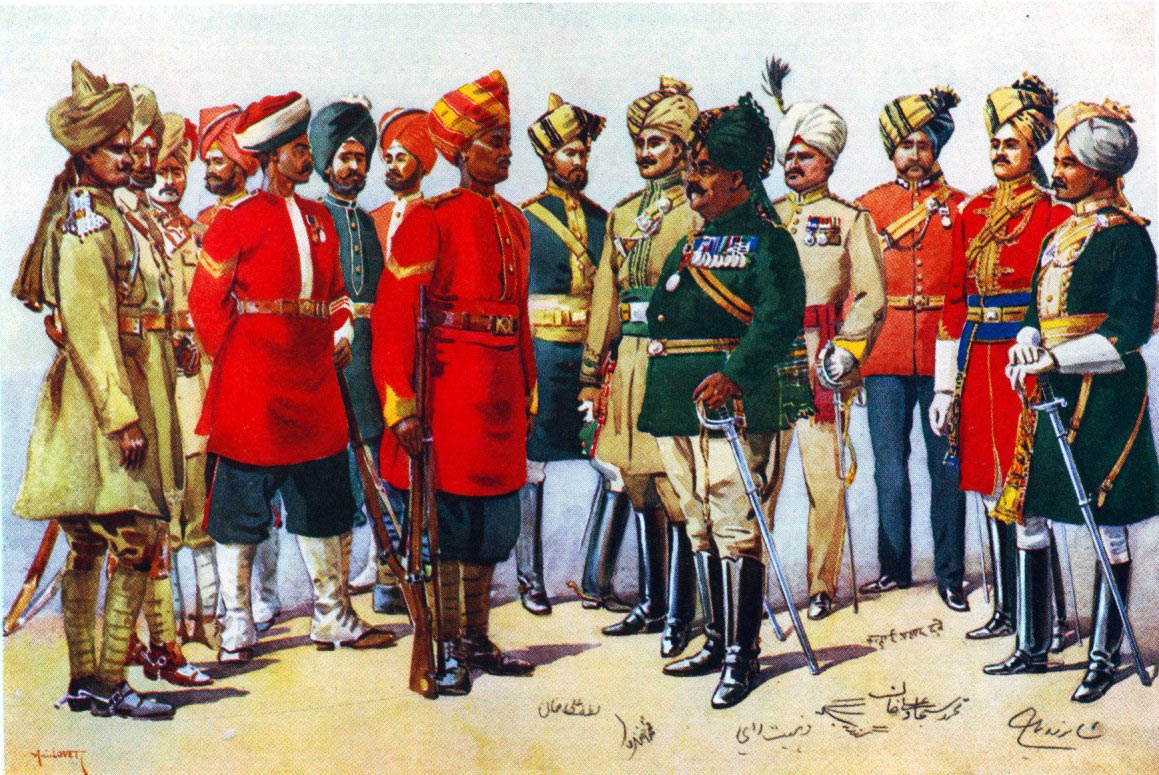Black Mountain Expedition 1891, from 1st March 1891 to 29th May 1891; the follow-up to the operation in 1888
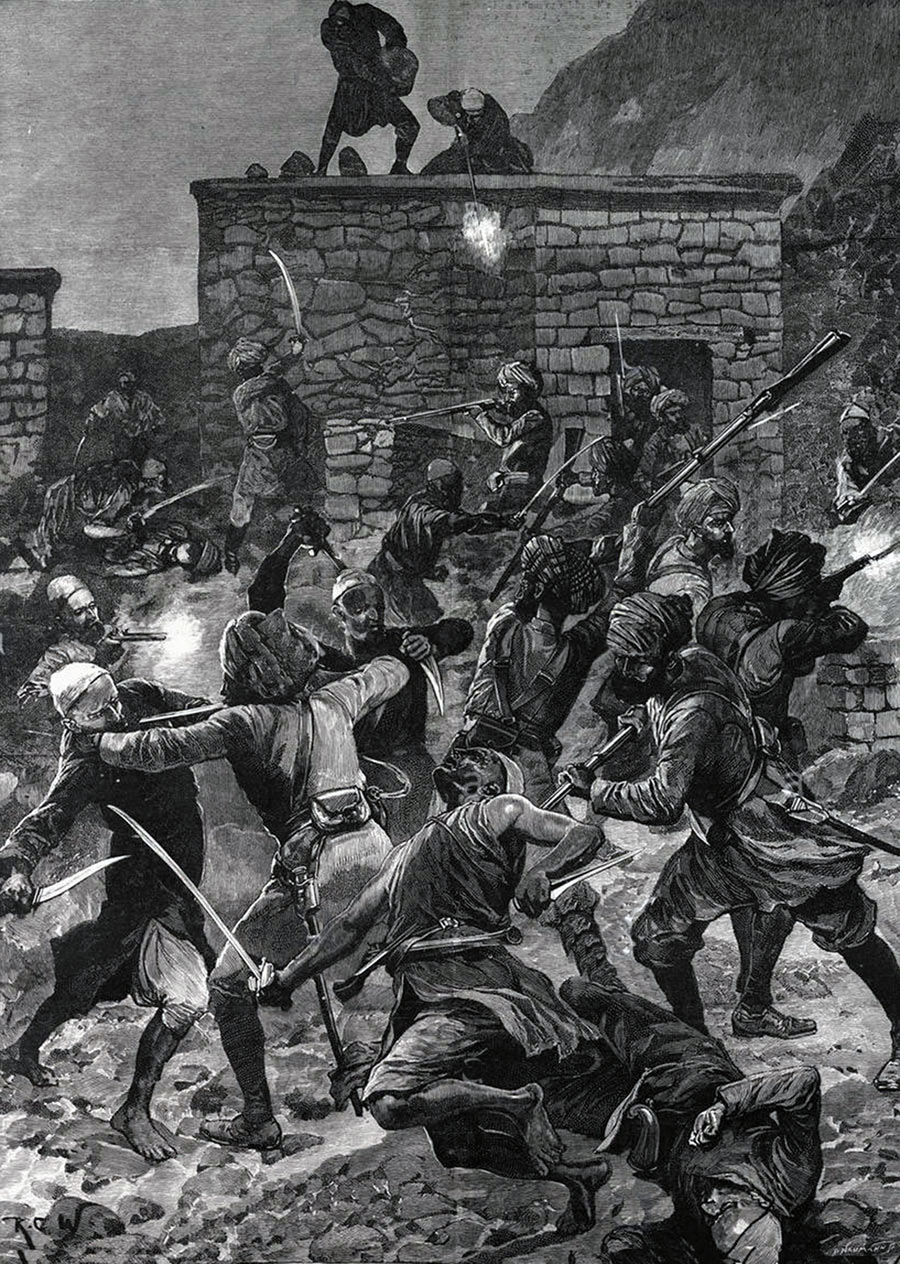
The Ghazi attack on the 4th Sikhs in Ghazicot on 19th March 1891: Black Mountain Expedition, 1st March 1891 to 29th May 1891 on the North-West Frontier in India: picture by Richard Caton Woodville
The previous battle in the North-West Frontier of India sequence is the Black Mountain Expedition 1888
The next battle in the North-West Frontier of India sequence is Waziristan 1894
To the North-West Frontier of India index
War: Operations on the North-West Frontier of India.
Date of the Black Mountain Expedition of 1891: 1st March 1891 to 29th May 1891.
Place of the Black Mountain Expedition of 1891: Hazara, on the banks of the Indus River in the Hindu Kush Mountains.
Combatants in the Black Mountain Expedition of 1891: British and Indian troops against the Hassanzai and Akazai tribes of Pathans.
Commanders in the Black Mountain Expedition of 1891: Major-General W.K. Elles, CB, commanded the Black Mountain Expeditionary Force. There does not appear to have been any central tribal leadership. Hashim Ali appeared as a leader of the Akazai, but left the region during the fighting.
Size of the forces in the Black Mountain Expedition of 1891: 7,300 British and Indian troops with 15 guns against probably around 8,000 tribesmen.
Uniforms, arms and equipment in the Black Mountain Expedition 1891:
The British military forces in India fell into these categories:
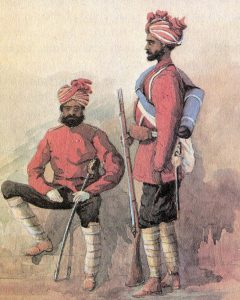
Bengal Infantry: Black Mountain Expedition, 1st March 1891 to 29th May 1891 on the North-West Frontier in India
- Regiments of the British Army in garrison in India. Following the Indian Mutiny of 1857, India became a Crown Colony. The ratio of British to Indian troops was increased from 1:10 to 1:3 by stationing more British regiments in India. Brigade formations were a mixture of British and Indian regiments. The artillery was put under the control of the Royal Artillery, other than some Indian Army mountain gun batteries.
- The Indian Army comprised the three armies of the Presidencies of Bombay, Madras and Bengal. The Bengal Army, the largest, supplied many of the units for service on the North-West Frontier. The senior regimental officers were British. Soldiers were recruited from across the Indian sub-continent, with regiments recruiting nationalities, such as Sikhs, Punjabi Muslims, Pathans and Gurkhas. The Indian Mutiny caused the British authorities to view the populations of the East and South of India as unreliable for military service.
- The Punjab Frontier Force: Known as ‘Piffers’, these were regiments formed specifically for service on the North-West Frontier and were controlled by the Punjab State Government.
- Imperial Service Troops of the various Indian states, nominally independent but under the protection and de facto control of the Government of India. The most important of these states for operations on the North-West Frontier was Kashmir.
A British infantry battalion comprised 10 companies with around 700 men and some 30 officers. A battalion had a maxim machine gun detachment of 2 guns and some 20 men.
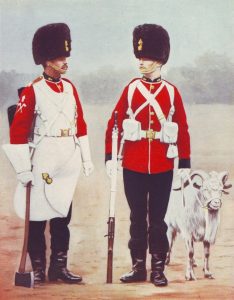
Royal Welch Fusiliers in home service dress: Black Mountain Expedition, 1st March 1891 to 29th May 1891 on the North-West Frontier in India
Indian infantry battalions had much the same establishment, without the Maxim gun detachment. Senior officers were British holding the Queen’s Commissions. Junior officers were Indian.
In 1891, British and Indian infantry regiments were issued with the single shot drop action Martini-Henry breech loading rifle. Imperial Service troops and the Khyber Rifles were issued with the Snyder rifle, a clumsy adaptation of the muzzle loading Enfield rifle to a breech loader.
The Indian Mountain Batteries used 7 pounder rifled muzzle loading guns that were dismantled and carried on mules. These guns were unreliable and difficult to use effectively. The British batteries used the more modern 2.3 inch rifled muzzle loaders.
Winner of the Black Mountain Expedition of 1891: The British and Indian troops of the Black Mountain Expeditionary Force.
Background to the Black Mountain Expedition of 1891:
In 1891 the north-western border of British India was the boundary of the old Sikh state of the Punjab. The border followed the Indus River north to a point short of the Black Mountain, where the border diverged and followed a mountain crest to the north east, while the Indus River continued roughly north.
The tribes involved in this campaign lived in the area of the Black Mountain and were the Pathan tribes of Hassanzais and Akazais (both sub-clans of the Yusufzai, being descended from sons of Yusuf, said to be the ancestor of the tribal group). The Hassanzais lived on both sides of the Indus River and comprised ten sub clans with a fighting strength of around 2,000 men.
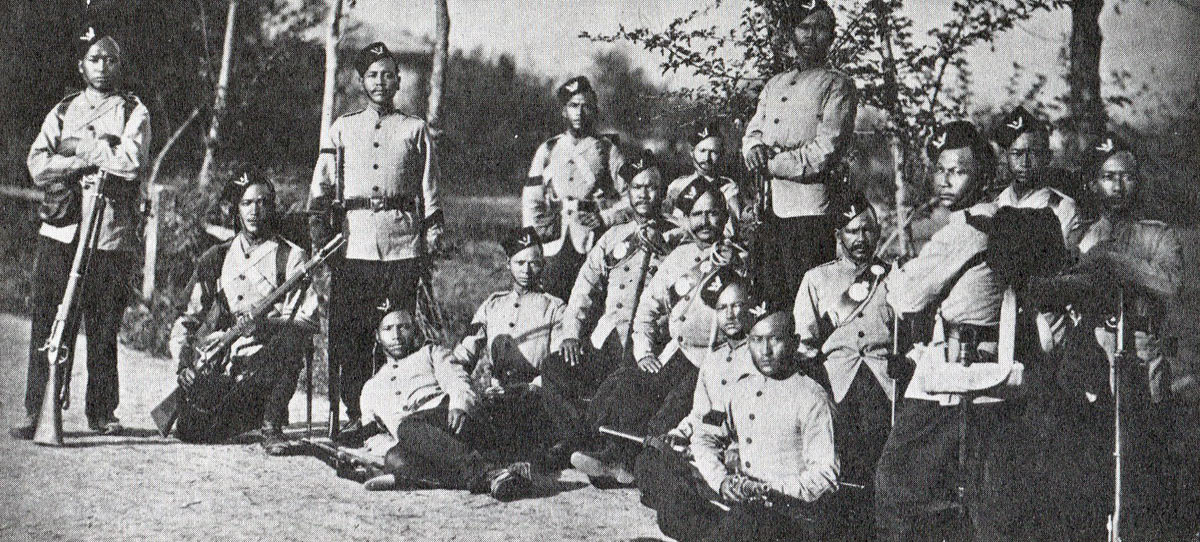
5th Gurkhas: Black Mountain Expedition, 1st March 1891 to 29th May 1891 on the North-West Frontier in India
The Akazais occupied the section of the Black Mountain to the north of the Hassanzais, on the east side of the Indus River. The Akazais comprised four sub-clans and could put around 1,500 fighting men into the field.
Once fighting began, many Pathans from other tribes and non-Pathans from the north were drawn into the conflict from a variety of motives, including fear of British encroachment on their own area.
The main traditional weapons of the tribesmen were long jezails or muskets, swords and shields and knives. Increasingly in the 1880s and 1890s, as the North-West Frontier become more violent due to the threat from the British, modern rifles came into the area and were widely used by the tribes.
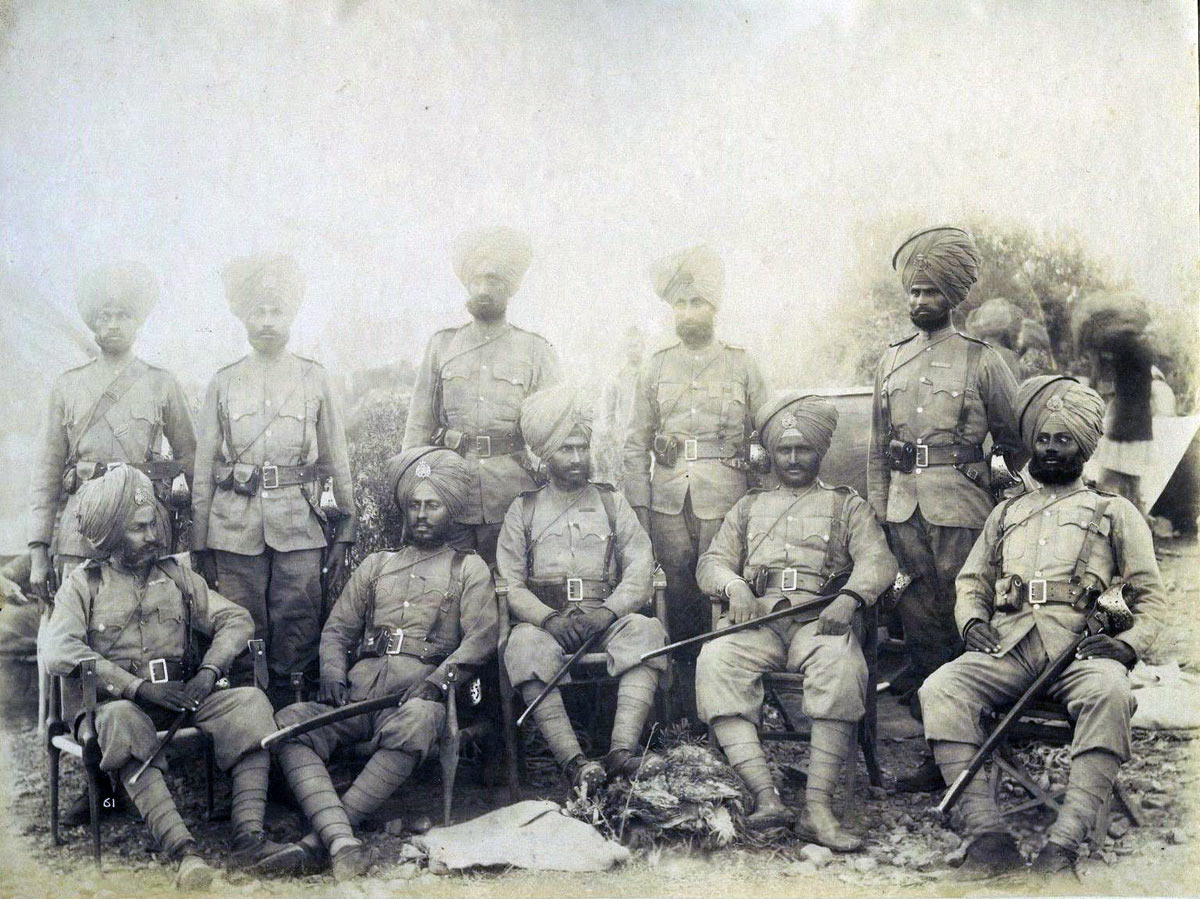
Sikh soldiers: Black Mountain Expedition, 1st March 1891 to 29th May 1891 on the North-West Frontier in India
A force of tribal fighting men would receive direction from headmen or religious leaders, but no Pathan felt compelled to do what he was told. Movement around the battlefield was guided by common enterprise and fighting experience rather than command.
Pathans were agile, swift and experienced mountain fighters. The Pathan code readily gave rise to blood feuds between individuals, villages and tribes. In the face of an external enemy, the Pathans would put their feuds to one side while the invader was resisted. Many of the tribes raided across the border into British territory. There were close links between the inhabitants of the Agror Valley, who lived under British rule and their kin across the border, which increased the tribal resentment at the existence of the border, an alien and incomprehensible concept.
The British authorities found the lawlessness of many of the tribes unacceptable and felt bound to protect their Indian subjects, who were required to give up their weapons and consequently fell easy prey to raiding Pathans from outside British jurisdiction. In the 1880s, the British adopted a policy of extending British India up to the Afghan border, with the inevitable annexation of independent tribal country.
An important purpose of a British North-West Frontier operation was to improve communications in the tribal area invaded, by building tracks, roads and bridges and establishing garrisons in key places, thereby facilitating any subsequent incursion.
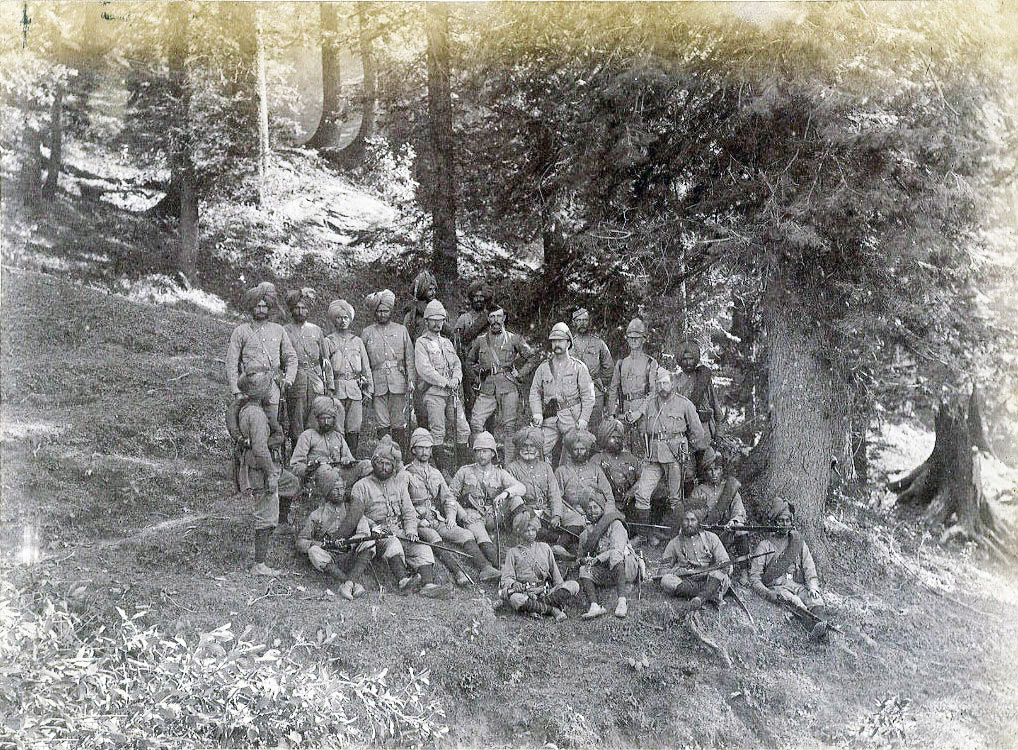
Group of 3rd Sikhs at Chittabat: Black Mountain Expedition, 1st March 1891 to 29th May 1891 on the North-West Frontier in India
The Black Mountain Expedition of 1891 followed as a direct result of the previous operation in 1888 (see Black Mountain 1888). An important obligation imposed on the Hassanzais and Akazais as border tribes, in 1888, was to permit British forces to move freely along the border, running north east of the Indus through the mountains. The border followed a mountain crest.
As part of the development of the region and to improve accessibility for their forces, the British built roads up to the border, from the Agror Valley on the Indian side and it was proposed to build a road along the border. It was clear that this was not acceptable to the Pathans living on the far side of the border who, perhaps unsurprisingly, felt that their continued independence was under threat.
The Hassanzais, Akazais and Pariari Sayids were ordered to send in jirgas to agree to the construction of the border road and to accompany a military force along the route. The Hassanzais and Akazais refused and expressed their objection to the road. They were threatened with punishment. The Pariari Sayids did send in their jirga.
A military force was sent to the area to march along the border and test the tribes’ reaction. The force was commanded by Brigadier-General Sir John McQueen, commander of the Hazara Field Force in 1888, now commanding the Punjab Field Force and comprised the 4th Sikh Infantry, 1st and 2nd Battalions of the 5th Gurkhas and No 2 ‘Derajat’ Mountain Battery, an ‘All Piffer’ contingent.
The force marched from Abbottabad to Oghi Fort, arriving on 19th October 1890. McQueen’s instructions were to ‘test the water’, but not to be involved in heavy fighting and to withdraw if it was clear that his march was to be seriously opposed.
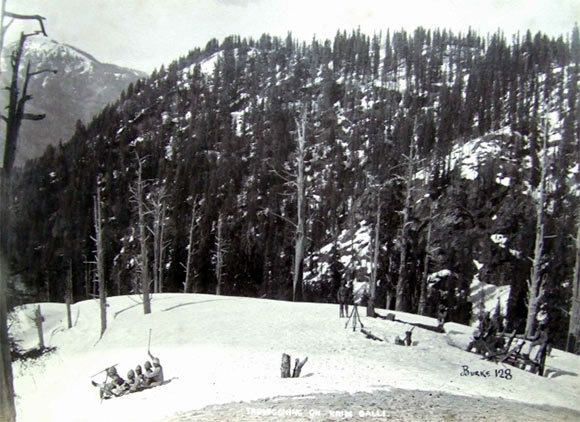
Kain Gali: Black Mountain Expedition, 1st March 1891 to 29th May 1891 on the North-West Frontier in India
There were reports that the tribesmen were gathering at Nimal, Kain Gali and elsewhere, under the leadership of Hashim Ali, the Khan of the Isazais, the superior tribe of which both the Hassanzais and the Akazais were part.
Rain and snow delayed the departure of McQueen’s force until 23rd October 1890, when he marched with a force of 1,000 men and 4 guns up the Barchar Spur and bivouacked above Barchar village, near the border. There was heavy firing towards the bivouac from the tribesmen during the night, but little damage was done due to the camp being on the reverse slope of the mountain. Reports came in that Hashim Ali was leading both Hassanzai and Akazai in a mass of tribesmen that was assembling on the border crest. McQueen obeyed his instructions and withdrew his force.
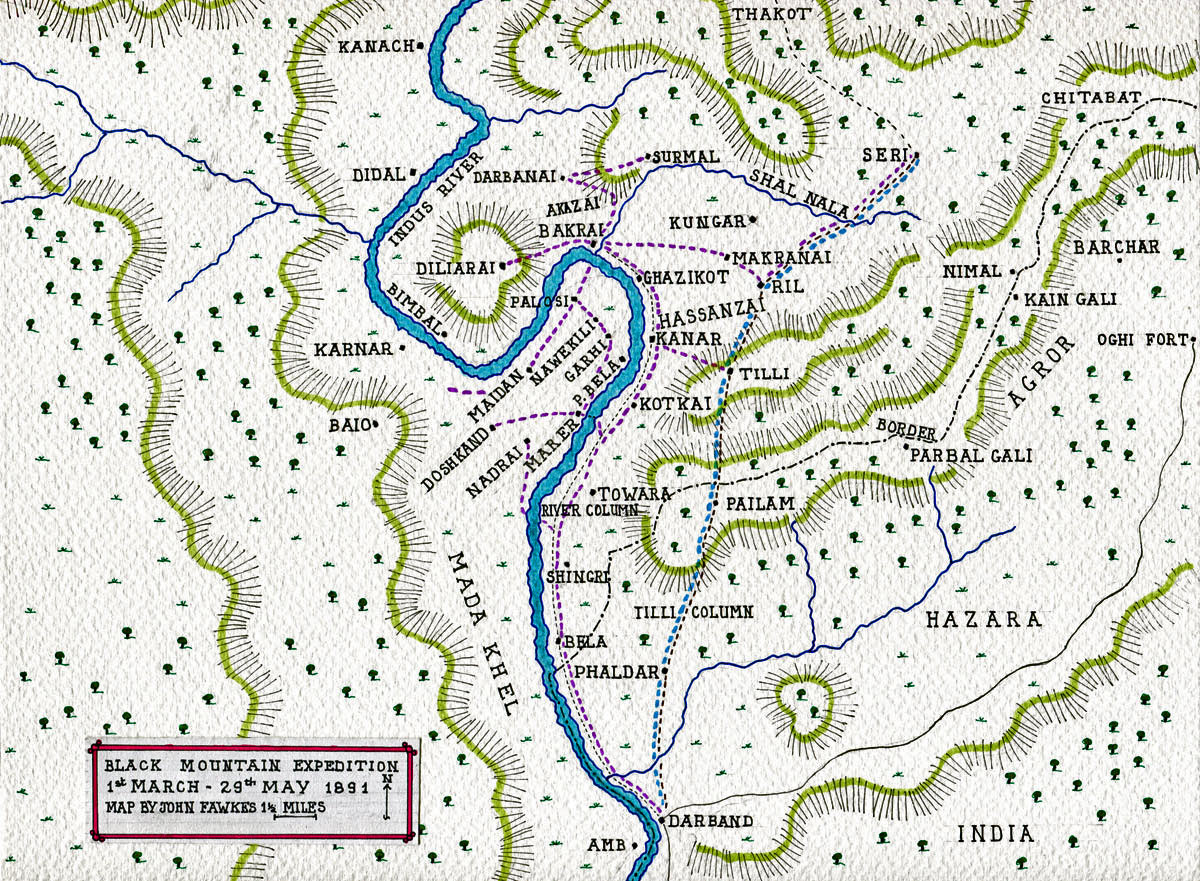
Map of the Black Mountain Expedition, 1st March 1891 to 29th May 1891 on the North-West Frontier in India: map by John Fawkes
Account of the Black Mountain Expedition of 1891:
In view of the opposition presented to Brigadier-General McQueen’s force, the Governor General of India determined to send a force into the Hassanzai and Akazai country to enforce the British right to march its forces along the border and to inflict punishment on the two tribes for their hostile actions against McQueen’s force.
The Government of the Punjab was instructed to inform the two tribes that the incursion would take place whether they submitted or not, but that if they did submit, all previous penalties would be remitted and discussions could take place on how to implement the British requirements with the minimum of difficulty.
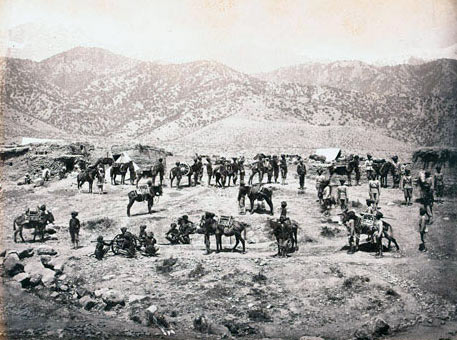
Derajat Mountain Battery: Black Mountain Expedition, 1st March 1891 to 29th May 1891 on the North-West Frontier in India
The experience of the incursion into the Black Mountain country in 1888 now became of great importance. The same survey officer, Captain Wahab, Royal Engineers, accompanied both expeditions. It was decided that the 1891 incursion should follow the Indus River (the route taken in 1888 by the Fourth Column), with one subsidiary incursion into the hills running parallel to the river route, to occupy Pabal Gali and Tilli.
It was acknowledged that the 1888 incursion into the hinterland of the Black Mountain country (the routes taken in 1888 by the First, Second, Third and Fifth Columns) had been too difficult and time consuming and that most of the villages it was intended to destroy lay along or near the Indus River. A small force was to be stationed at Oghi Fort for defensive purposes only.
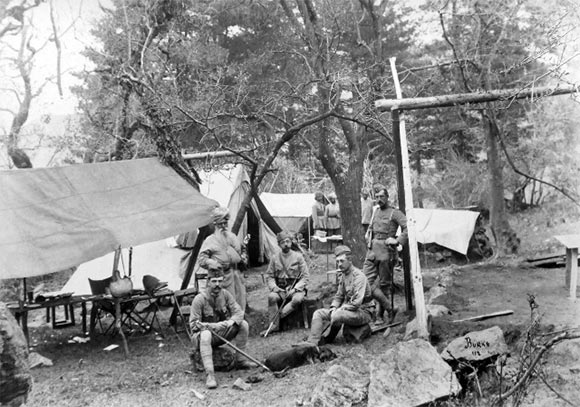
The Political Officers’ camp at Seri: Black Mountain Expedition, 1st March 1891 to 29th May 1891 on the North-West Frontier in India
The force was designated the ‘Black Mountain Expedition 1891’ and placed under the command of Major-General W.K. Elles, CB (an officer from the British Army). Mr Cunningham CIE CS was appointed Chief Political Officer under the general officer commanding the expedition.
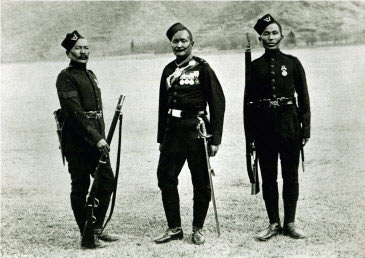
Sergeant, Gurkha officer and private of 5th Gurkhas: Black Mountain Expedition, 1st March 1891 to 29th May 1891 on the North-West Frontier in India
Regiments in the Black Mountain Expedition of 1891:
No 1 Mountain Battery Royal Artillery
No 9 Mountain Battery Royal Artillery
1st Royal Welch Fusiliers
1st King’s Royal Rifle Corps
2nd Seaforth Highlanders
11th Bengal Lancers
No 4 Company Bengal Sappers and Miners.
11th Bengal Infantry
19th Bengal Infantry
27th Bengal Infantry.
28th Bengal Infantry
32nd Pioneers
37th Bengal Infantry (Dogras)
3rd Sikh Infantry
4th Sikh Infantry
No 2 (Derajat) Mountain Battery
2nd/5th Gurkhas
Guides Infantry
Khyber Rifles
Cooly Corps (200 men).
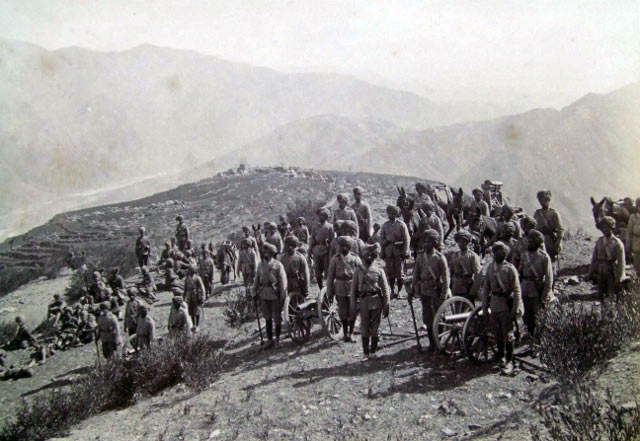
Number 2 (Derajat) Mountain Battery: Black Mountain Expedition, 1st March 1891 to 29th May 1891 on the North-West Frontier in India
The composition of the columns:
The Indus River Column, commanded by Brigadier-General RF Williamson of the Royal Welch Fusiliers, comprised 2nd Seaforth Highlanders, a wing of 32nd Pioneers, 37th Bengal Infantry (Dogras), the Guides Infantry, 4th Sikh Infantry, No 1 Mountain Battery, Royal Artillery (3 guns) and No 2 (Derajat) Mountain Battery (3 guns).
The Tilli Column, commanded by Brigadier AG Hammond VC ADC of the 3rd Sikh Infantry, comprised 1st Royal Welch Fusiliers, 11th Bengal Infantry, a wing of 32nd Pioneers, 2nd/5th Gurkhas, Khyber Rifles and No 9 Mountain Battery, Royal Artillery (6 guns).
Divisional Troops at Darband comprised 1 squadron of 11th Bengal Lancers and No 4 Company Bengal Sappers and Miners.
The Oghi Column, commanded by Colonel GS Hills of 28th Bengal Infantry, comprised 1 squadron of 11th Bengal Lancers, 28th Bengal Infantry and No 2 (Derajat) Mountain Battery (3 guns).
The Reserve Brigade at Rawalpindi comprised 1 squadron of 11th Bengal Lancers, 1st King’s Royal Rifle Corps, 19th Bengal Infantry and 27th Bengal Infantry.
Lieutenant HCI Birdwood RE commanded the Cooly Corps (200 men).
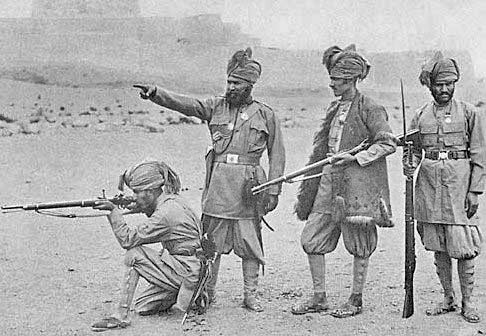
Khyber Rifles: Black Mountain Expedition, 1st March 1891 to 29th May 1891 on the North-West Frontier in India
The force was ordered to concentrate at its two bases, the River Column and the Tilli Column at Darband and the Oghi Column at Oghi, by 1st March 1891 and begin operations as soon as practicable.
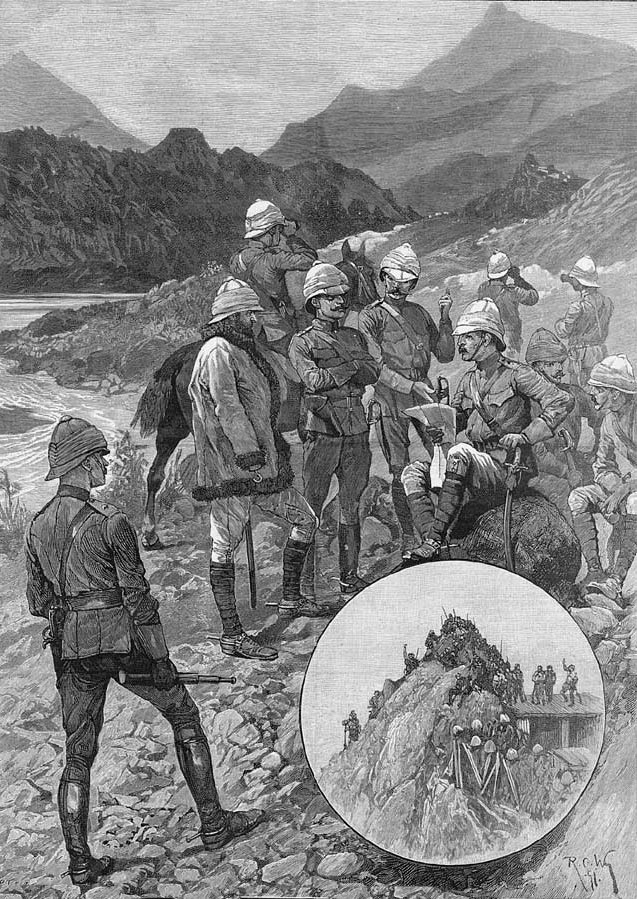
General Elles sights the tribesmen at Shingri: Black Mountain Expedition, 1st March 1891 to 29th May 1891 on the North-West Frontier in India: picture by Richard Caton Woodville
Delays were caused by bad weather, but the force was ready by 11th March 1891, when the two active columns advanced, to Bela on the Indus and to Phaldar in the mountains. During the delay, work had been completed on the roads, on the Indus River route to Bela and on the upland route to a point short of the border. Telegraph lines had been laid to Bela and to Phalder.
On the 11th March 1891, boats were brought up to Bela to form a bridge across the Indus River and four days supplies were conveyed to Bela and to Phalder.
Shots were fired across the Indus River at the River Column. Otherwise there was little sign of resistance. Reports indicated that both the Hassanzais and the Akazai were pressing Hashim Ali not to resist the British advance and to send in a jirga to the British. Taking advantage of this information, the tribes were notified that if they remained in their villages and did not resist the troops no injury would come to them or their villages.
On 11th March 1891, a jirga arrived in Amb, a village across the Indus from Darband, from the Bunerwal tribe, expressing concern at the British operations. A second jirga arrived from the Mada Khel. The Mada Khel country lay along the west bank of the Indus River and the Bunerwal country lay further to the west. General Elles informed both tribes that he did not intend to interfere with them provided they took no part in resisting his troops.
Major-General Elles’s plan was for the River Column to advance up the Indus River by the east bank to Kanar. At that place, the Mada Khel country on the west bank gave way to the Hassanzai country. A detached force would cross by a bridge of boats and occupy the Hassanzai country on the west bank.
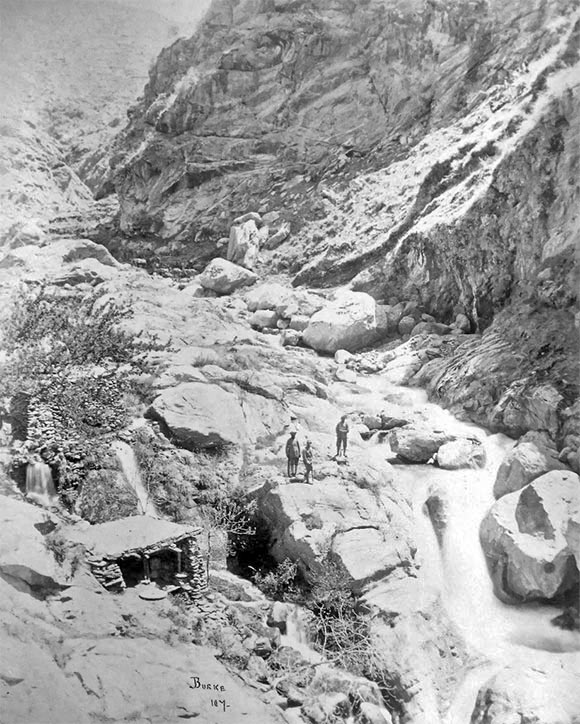
The Shal Nala: Black Mountain Expedition, 1st March 1891 to 29th May 1891 on the North-West Frontier in India
The River Column would then move into the Diliarai peninsula, that lay directly to the north of the Hassanzais on the east bank and occupy the Akazai country. The River Column would then work its way up the Shal Nala, a mountain stream which flowed through the Akazai country and joined the Indus River at the southern point of the Diliarai peninsula, to meet the Tilli Column.
As it was now clear that little resistance would be expected from the Hassanzais, a quarter of their crops would be taken unless there was active fighting, in which case further punishment would be inflicted.
The Tilli Column would advance across the mountainous route to Tilli and then to Ril and Kungar, where it would occupy the eastern areas of the Akazai country. The Tilli Column would then work its way down the Shal Nala stream and meet the River Column.
Major-General Elles and his headquarters would accompany the River Column.
Operations begin:
The River Column marched from Darband at 8.30am on 12th March 1891. The tribesmen began firing from across the Indus River at the point where Mada Khel country gave way to Hassanzai country. Their targets were the troops on the road and the boats being brought up the Indus for the bridge.
A company of the Guides crossed the Indus River and worked its way up the west bank in conjunction with the boats. All the villages on the west bank the Guides passed through were found to be abandoned.
The River Column bivouacked at Towara, the scene of the major action in 1888. At Towara a second company of Guides crossed the Indus to the west bank.
On 13th March 1891, the two companies of the Guides on the west bank moved up into the hills to the village of Nadrai. The troops came under fire, but rushed the village without casualty. The tribesmen suffered 3 dead and 3 wounded. The Guides burnt Nadrai as a reprisal for the resistance shown before moving on.
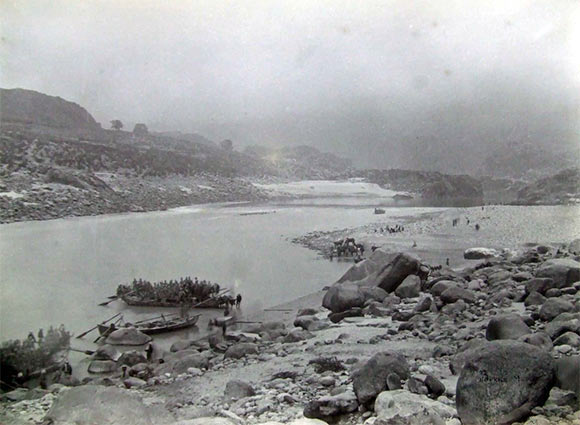
British and Indian troops crossing the Indus by the Marer Ferry: Black Mountain Expedition, 1st March 1891 to 29th May 1891 on the North-West Frontier in India
On the morning of 13th March 1891, a further detachment from the River Column, comprising a half battalion of the 2nd Seaforth Highlanders and a half battalion of the Guides, crossed to the west bank by the Marer ferry. This detachment moved up the hill behind Nadrai to the village of Doshkand, which was deserted and back to the river bank, where the villages of Garhi, Nawekili and Palosi were visited and found to be deserted. None of these villages was damaged. The Hindustani settlement at Maidan was found to be still in ruins after its destruction in 1888. The two companies of Guides that had stormed Nadrai joined the detachment at Garhi.
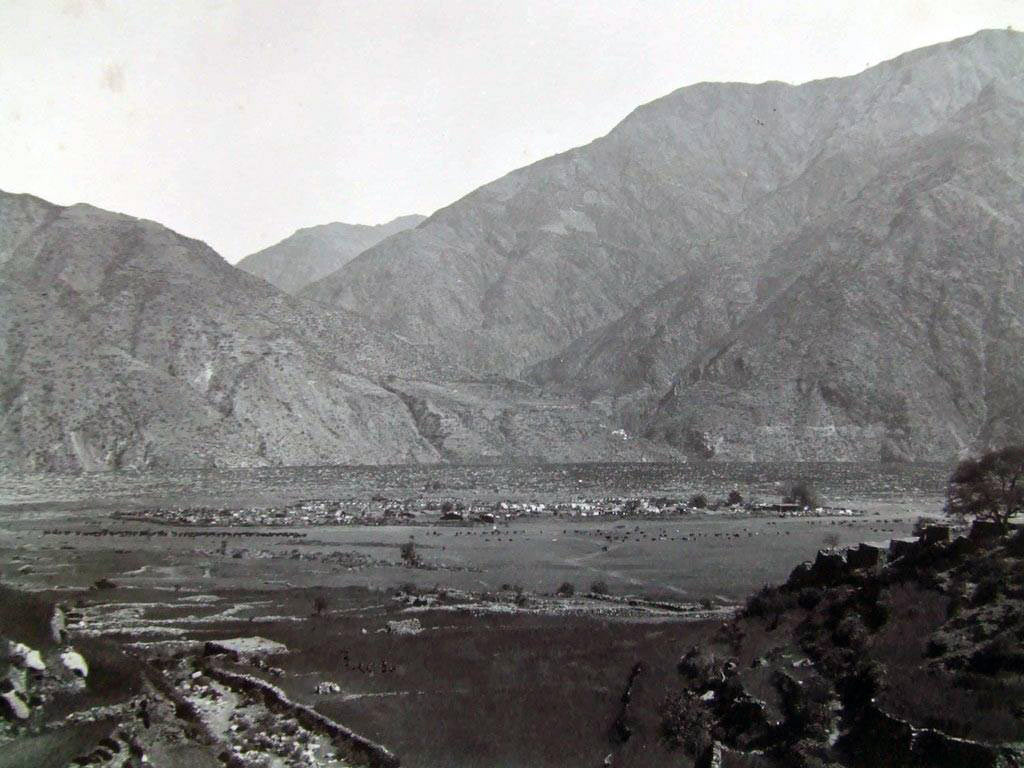
Palosi village: Black Mountain Expedition, 1st March 1891 to 29th May 1891 on the North-West Frontier in India
The main part of the River Column stayed a further night at Towara, as the east bank track from Kotkai to Kanar was found to need work to enable the passage of baggage animals.
On 15th March 1891, the River Column conducted a reconnaissance across the Indus River in the area of Palosi, to find a suitable site for an encampment and to investigate a reported gathering of tribesmen further to the west. The reconnaissance party came under fire from both sides of the river and it became clear that, although the Hassanzai were no longer resisting the British advance, other tribes were being drawn into the fighting. The reconnaissance party advanced beyond Maidan, the old Hindustani settlement, and saw large gatherings of armed tribesmen on the hills on both sides of the Indus River. The party withdrew to the main encampment at Towara on the east bank.
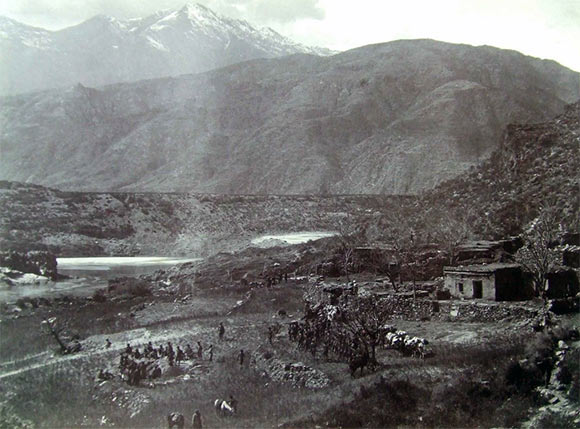
Village of Ghazikot: Black Mountain Expedition, 1st March 1891 to 29th May 1891 on the North-West Frontier in India
A detachment from the 4th Sikhs advanced from Kanar through Ghazikot and surprised a party of armed tribesmen, inflicting casualties.
On 14th and 15th March 1891, the Chief Political Officer received reports that parties of armed tribesmen carrying flags had been seen crossing the Baio Range of Mountains from the west and approaching the villages of Karnar and Kamach on the west bank of the Indus River. The leader of the ‘Hindustani Fanatics’, Maulvi Abdulla, was reported to be with them. The presence of hostile tribesmen from other areas showed that the scale of the fighting was escalating, despite the submission of the Hassanzai. As the main lever against tribesmen available to the British was the threat to destroy their villages and crops, the gathering of hostile outsiders presented considerable problems for the British.

Black Mountain Expedition, 1st March 1891 to 29th May 1891 on the North-West Frontier in India: picture by WH Overend
The Tilli Column:
Meanwhile, the activities of the Tilli Column were showing that the assessment of the difficulties of operating in the mountainous areas at that time of the year was entirely justified.
The Tilli Column marched out from Darband on 12th March 1891 to Pailam. No opposition was encountered. The Column crossed the border on 13th March 1891 and moved on to Tilli, where the Column halted.
On 15th March 1891, Brigadier-General Hammond reported to the GOC that the Tilli Column was having trouble in finding enough forage in that area. The location was high and the crops were insufficiently far advanced. The village of Seri was reported to be still under snow.
Major-General Elles issued orders for a change of plan. The track from Tilli to Kanar was to be opened up and the Tilli Column brought down to join the River Column at Palosi on the west side of the Indus. Outposts would be established at three villages in the mountains above the east bank track; Tilli, Ril and Makranai. Before moving his column to the Indus River, Brigadier Hammond was ordered to take a flying column to raid Seri and destroy that village’s defences.
On 16th March 1891, a wing of the 4th Sikhs moved to Kanar to assist in building the road to Tilli and the bridge of boats was completed at Kotkai, spanning 110 yards of the Indus River, with a camel road on the west side leading to the camp at Palosi.
At this time, reports were coming in to the Chief Political Officer that the Hassanzai and the Akazai were anxious to submit to the British. Directions were sent out that they should return to their villages and that only a quarter of their crops would be sequestered. A further requirement was that the leader, Hashim Ali, and his family be surrendered. However, it was clear that hostilities were far from finished.
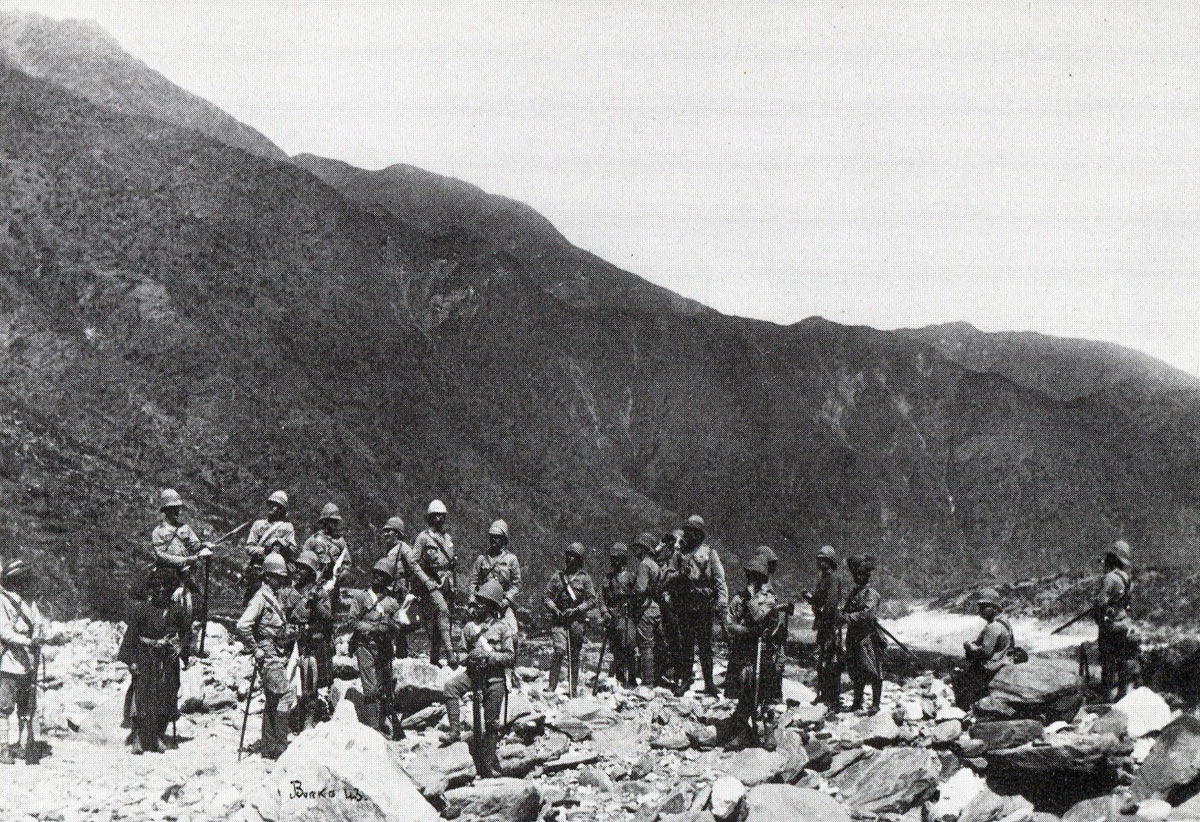
British troops in the Indus Valley: Black Mountain Expedition, 1st March 1891 to 29th May 1891 on the North-West Frontier in India
On 16th March 1891, reports came in that the Hindustanis, under Maulvi Abdulla, were collecting at Didal and numbers of Chagarzai tribesmen at Kamach, both villages on the west bank of the Indus River to the north of the Diliarai peninsula. In addition, Hashim Ali, after attempting to rouse his own followers in the area of Seri, in the mountains to the east of the Indus River, was in Swat, attempting to persuade its ruler, Mian Gul, to lead a jihad against the British.
The action at Ghazikot:
The Dogra Company of the 4th Sikhs, 2 Indian officers and 67 soldiers commanded by Subadar Dheru, held the village of Ghazikot, the most northerly village on the east bank of the Indus River reached by the River Column. The village comprised a narrow street with a mosque at the south-east corner.
Nullas, or dry watercourses, ran across the track to the north and south of the village. A piquet of Dogras was in position behind a wall to the north of the village, while the rest of the company was bivouacked behind the mosque. The piquet came under fire during the evening of 18th March 1891 and at 3am on 19th, the havildar of the piquet reported to Subadar Dheru that tribesmen were collecting in force in the nulla in front of his position. The tribesmen emerged from the nulla and rushed forward, yelling and banging drums. The piquet fired four volleys at the tribesmen, who charged around them and into the village, where they occupied buildings, including the mosque, that overlooked the bivouac and opened fire. The piquet re-joined the rest of the company and a heavy fire fight developed, during which tribesmen armed with swords and shields repeatedly attempted to charge the Dogras, many emerging from the mosque.
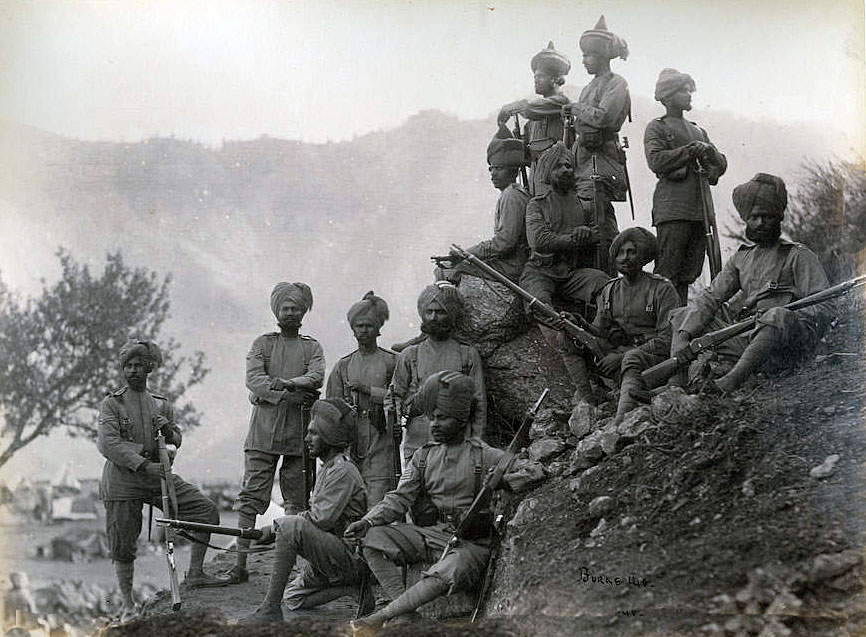
Soldiers of the 4th Sikhs: Black Mountain Expedition, 1st March 1891 to 29th May 1891 on the North-West Frontier in India
Within half an hour of the commencement of the attack, two further companies of the 4th Sikhs, commanded by Lieutenants Maconchy and Manning, arrived from Kanar in support of the Dogra company, followed by two companies of the 32nd Pioneers, commanded by Colonel Sir R Bromhead CB.
By this time, the tribesmen were well established in the mosque and on the roofs of the houses throughout the village and there was heavy firing. Lieutenant Maconchy and a half company of 4th Sikhs rushed up the village street, while Colonel Bromhead took his pioneer companies around the right side of the village and Lieutenant Manning took his company around the left side.
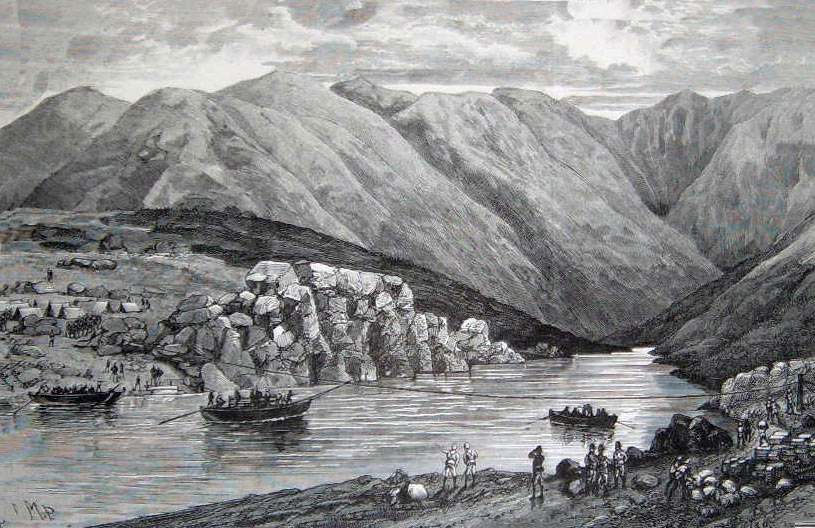
The flying bridge across the Indus at Bakrai: Black Mountain Expedition, 1st March 1891 to 29th May 1891 on the North-West Frontier in India: picture by Melton Prior
At dawn, Colonel Bromhead took his troops through the village, clearing it of hostile tribesmen. Most of the tribesmen had already left through the jungle on either side of the village during the night, leaving only some fanatical ‘ghazis’.
Captain DeBrath led a further company of 4th Sikhs for a mile up the east bank track, following the tribesmen’s line of retreat. 4 tribesmen were seen crossing the Indus River on a raft and a party of about 80 were seen crossing the Shal Nala and into the village of Bakrai. The area around Ghazikot was searched for any tribesmen hiding, but none were found.
The tribesmen were reported to have been almost entirely ‘Hindustani Fanatics’. 25 bodies were found in the village, of which 22 were identified as Hindustanis and 2 as Pathans. 1 was a Hindu hostage. British and Indian casualties were 4 dead and 21 wounded, including Lieutenant Maconchy.
That night, 19th March 1891, tribesmen fired at the troops in Kanar. The next morning reinforcements of two companies of Guides Infantry moved up from Towara to Kanar and two companies of Seaforth Highlanders moved up to the bridgehead at Kotkai, to reinforce the wing of the 37th Dogras, the regiment given the task of defending the bridge of boats. During the day’s fighting, the tribesmen suffered 3 dead and 3 soldiers of the 32nd Pioneers were wounded. A mule driver was found dead in the nulla to the south of Ghazikot.
On 20th March 1891, the River Column, with the divisional headquarters, moved out from Towara, crossed the bridge of boats at Kotkai to the west bank and moved up the Indus River to the village of Pirzada Bela. Tribesmen were seen in considerable numbers in the hills on the east side of the Indus River and the guns shelled the villages of Bakrai and Makranai.
The next day the River Column marched to its intended base in the village of Palosi, which it fortified.
The Tilli Column:
On 21st March 1891, the Tilli Column moved from Tilli to Ril. On 22nd March 1891, the column marched to Seri, destroyed the village and returned to Tilli.
The action at Diliarai:
On 23rd March 1891, the River Column built a flying bridge across the Indus River to the east bank at Bakrai, at the mouth of the Shal Nala. A covering force for the building of the bridge of three companies from 4th Sikhs crossed to the east bank and occupied Bakrai. In response, a large assembly of tribesmen gathered around Diliarai, a village on a high spur overlooking Bakrai and began to advance down the spur towards Bakrai. The 4th Sikh piquet was ordered to advance from Bakrai up the spur to meet the tribesmen. A wing of the Guides Infantry crossed the Indus River to support the Sikhs. The Sikhs drove the tribesmen back and occupied the crest of the hill where Diliarai stood at 5.30pm. They were joined by the Guides in Diliarai.
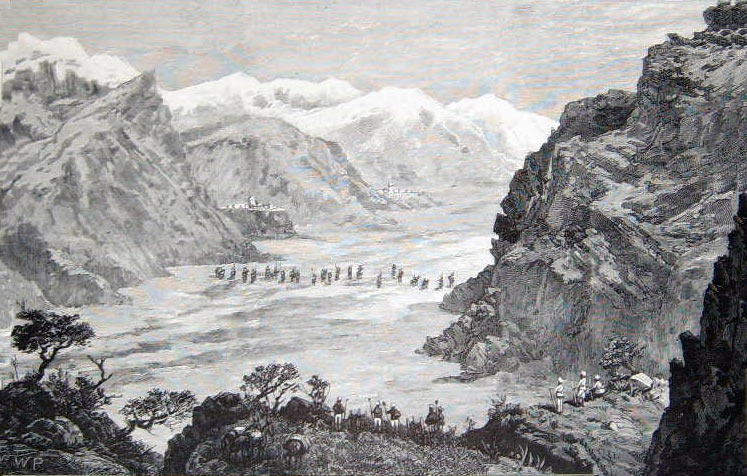
British and Indian troops crossing the Indus at Bakrai: Black Mountain Expedition, 1st March 1891 to 29th May 1891 on the North-West Frontier in India
The detachment of Sikhs and Guides was then ordered to withdraw from Diliarai to a breastwork which stood half-way down the slope between Diliarai and Bakrai. As this was where the detachment would have to spend the night, the order went contrary to the well-established principle of Frontier Warfare, that troops should always occupy the highest ground when in a static position. The detachment withdrew down the spur, covered by a rear-guard of 4th Sikhs. As soon as it was apparent that the troops were withdrawing, the tribesmen returned and attacked the rear-guard, their numbers increasing by the minute. By mid-evening, it became clear that the 4th Sikhs rear-guard could not easily extricate itself from the running battle that had developed on the slope back to Bakrai, even though there were terraces that provided defensive positions. The position of the 4th Sikhs and the Guides in Bakrai itself was under threat and the detachment was in danger of being overwhelmed.
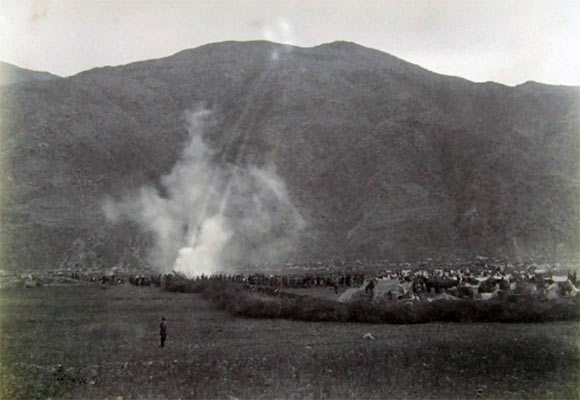
British guns shelling Diliarai: Black Mountain Expedition, 1st March 1891 to 29th May 1891 on the North-West Frontier in India
The commanding officer of the 4th Sikhs, Lieutenant-Colonel Gaselee, decided to re-occupy the crest at Diliarai. One company of 4th Sikhs moved out to the right flank, to provide covering fire directed at the tribesmen coming down from the crest, while Gaselee led the other two companies in an attack back up the spur. The tribesmen’s resistance collapsed and they were driven over the crest. Diliarai was occupied for the night by one company of 4th Sikhs and the wing of the Guides. The other two companies of 4th Sikhs returned to Palosi, as their ammunition was exhausted. No further fighting took place overnight, as the tribesmen appeared to have withdrawn from the area.
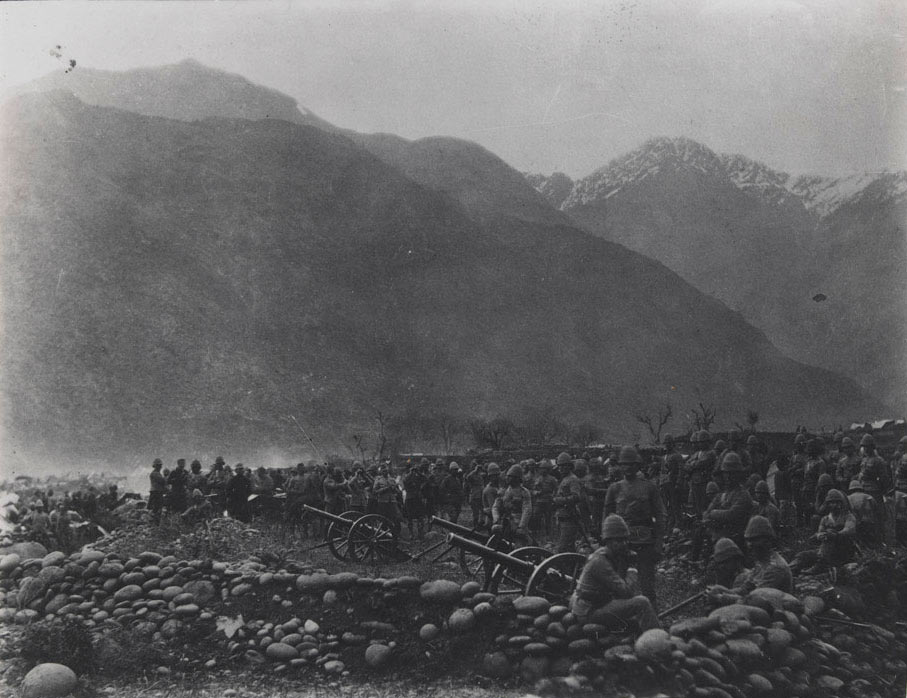
British No 1 Mountain Battery ceasing fire at Diliarai: Black Mountain Expedition, 1st March 1891 to 29th May 1891 on the North-West Frontier in India
Once the action was over, it was established that the tribesmen had been Chagarzais and Hindustanis. The tribesmen owned to suffering 12 dead and 16 wounded, although their true casualties were probably much greater. The British had 1 officer, Lieutenant Harman of 4th Sikhs and 4 soldiers wounded mainly in the hand to hand fighting.
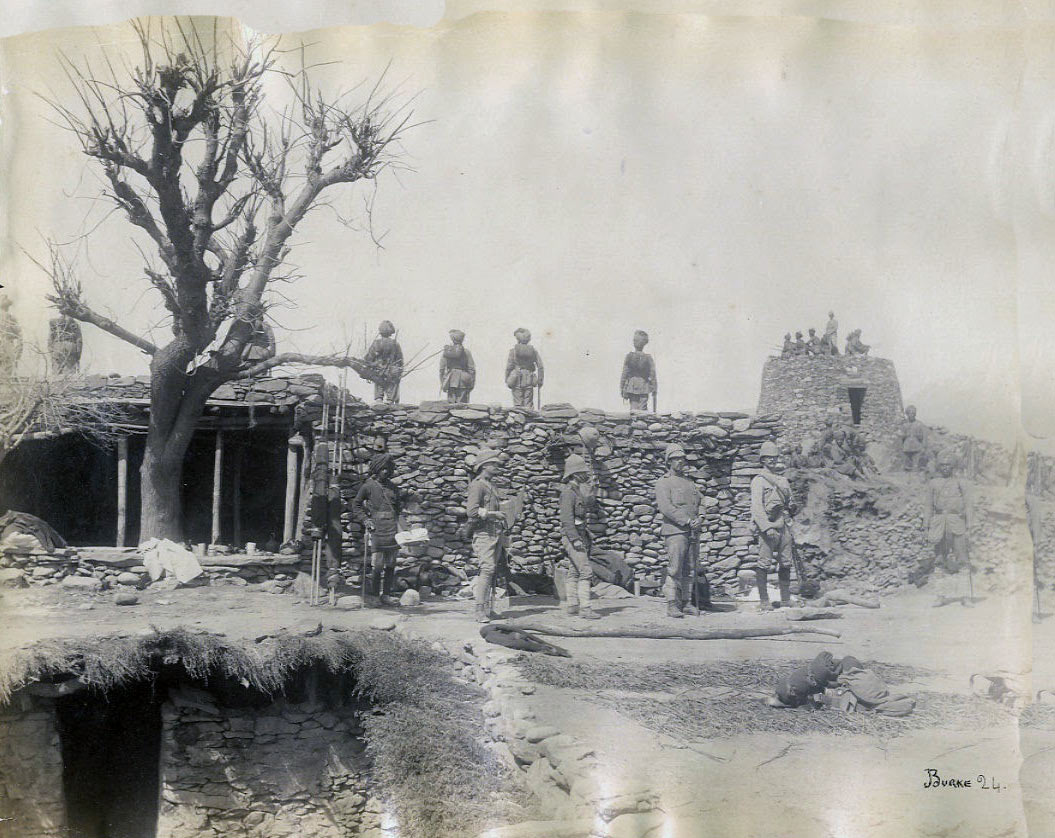
British and Sikh troops in Diliarai: Black Mountain Expedition, 1st March 1891 to 29th May 1891 on the North-West Frontier in India
On 24th March 1891, Major-General Elles reported that the Hassanzai, other than the Khan Khel, one of the Hassanzai sub-clans, had submitted; that the Akazai would submit, but that they were intimidated by mullahs and Chagarzai tribesmen. The GOC reported that the Chagarzai country was overrun by mullahs, talibs and other Muslim figures from other areas. Some Bunerwal tribesmen were in Baio, to the west of the Indus River, led by Mulla Faizi of Bajkatta and Akhund Khel of Kuria, but appeared only to be maintaining a watch on the situation. There did not seem to be a general gathering of the Bunerwal tribe.
The action at Darbanai:
On 25th March 1891, the whole of the 4th Sikhs were in position on the Diliarai crest, with 3 guns of No 2 Derajat Mountain Battery. This force provided cover for Brigadier-General Hammond to advance up the Shal Nala, with a force comprising 1st Royal Welch Fusiliers, 2 companies of 11th Bengal Infantry, a wing of 2nd/5th Gurkhas, the Khyber Rifles and 4 guns of No 9 Mountain Battery, Royal Artillery. Hammond’s target was Darbanai, a village on a 1,500 foot spur with a commanding view overlooking the Indus River. The track along the Shal Nala was extremely difficult. By 1pm Hammond had occupied a peak near to Darbanai, where he awaited the guns which were making slow progress up a track along the bed of the Shal Nala. Once the guns joined the infantry, the approach on Darbanai began. The Khyber Rifles advanced on the right of Darbanai, the Gurkhas on the left, while the Royal Welch Fusiliers and the 11th Bengal Infantry attacked in the centre. The tribesmen did not await the assault, but made off down the hillside towards the village of Surmal. The Royal Welch Fusiliers followed them up, while the Khyber Rifles cleared the hills on the right of for a considerable distance.
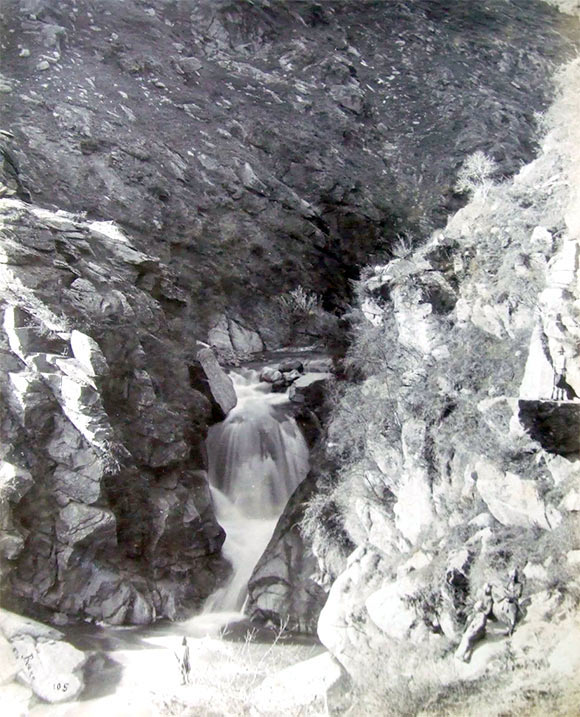
The Shal Nala: Black Mountain Expedition, 1st March 1891 to 29th May 1891 on the North-West Frontier in India
British losses in the day were Second Lieutenant Doughty of the Royal Welch Fusiliers killed and one soldier wounded. The tribesmen were estimated to have suffered around 40 casualties.
Water was supplied to Darbanai by an 800 foot channel from a source further up the mountain. The tribesmen cut this supply and continued to fire into the British camp in the village. Brigadier-General Hammond sent word to Surmal, where a number of armed tribesmen were gathered, that if the firing was not discontinued and the water supply not reconnected, Surmal would be destroyed.
On 27th March 1891, the water to Darbanai remained cut and the firing continued. Hammond decided to attack Surmal.
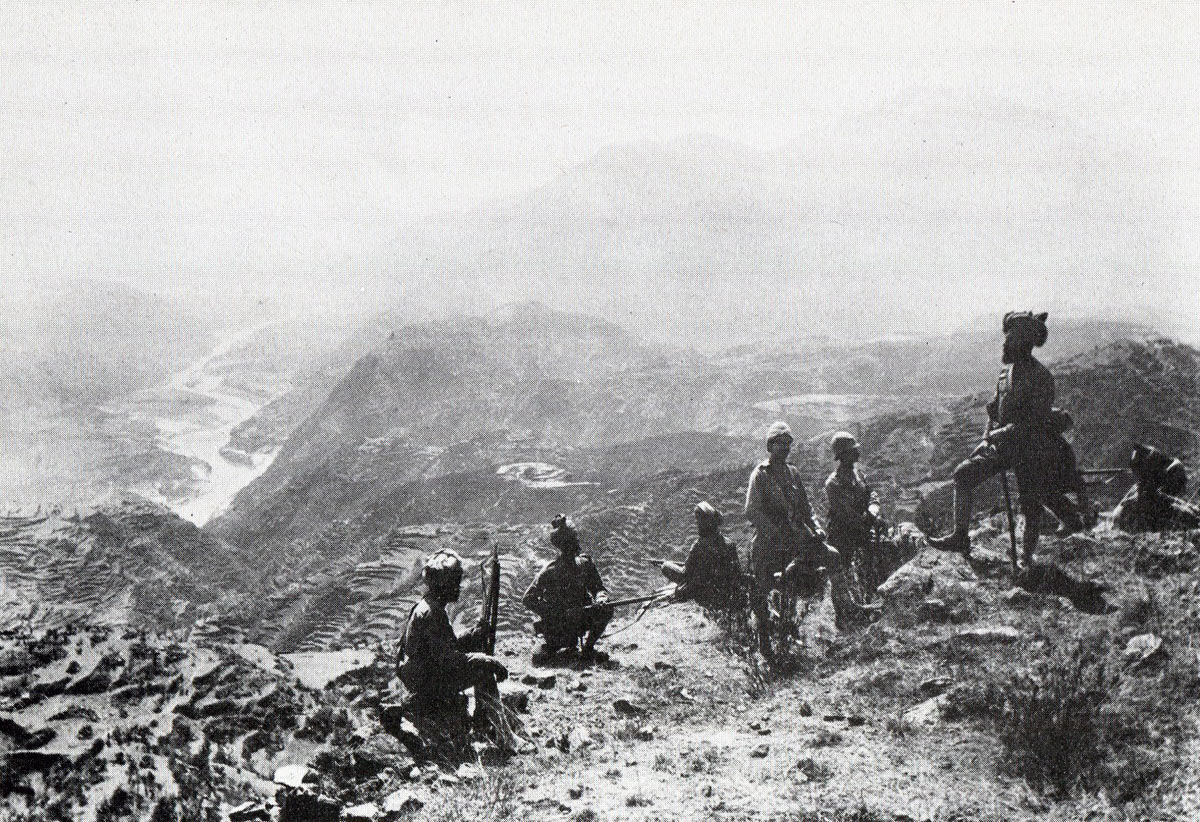
British and Sikh soldiers on Diliarai Heights: Black Mountain Expedition, 1st March 1891 to 29th May 1891 on the North-West Frontier in India
No 9 Mountain Battery took up a position covering Surmal. From Darbanai, the ground fell away to a nulla, with Surmal on a hill on the other side of the valley. The Khyber Rifles advanced on the right with 2nd/5th Gurkhas, while the Royal Welch Fusiliers, supported by 11th Bengal Infantry, mounted a direct attack on Surmal, descending the hillside, crossing the nulla and climbing the far hill to the village. The Mountain Battery opened fire on the tribesmen. The 500 armed tribesmen occupying the area of the village took cover from the gunfire behind the crest of the hill.
The Royal Welch Fusiliers and the Gurkhas reached Surmal at much the same time. The tribesmen did not wait to contest the village. The Khyber Rifles, with one company of the Gurkhas, encountered a second group of tribesmen of the same size, on the hill to the right of the village, which they dispersed with rifle fire.
Brigadier-General Hammond’s orders were not to go further into Chagarzai country. Two houses in Surmal were burnt. British losses were 3 wounded. It was estimated that the tribesmen, mostly Chagarzais, suffered around 120 casualties.
Tribal activity at Baio:
On 29th March 1891, the focus of concern moved back to Baio, to the west of the Indus River, where there continued to be a buildup of tribesmen from the Buner, Chamla, Amazai and Gadun areas. The presence of the British force in tribal territory to the west of the Indus River was the cause of the increase in tension. The British authorities moved 9th Bengal Lancers and 22nd Bengal Infantry from the Nowshera garrison to join the 1st Northumberland Fusiliers and the Guides Cavalry at Mardan, to the south-west of Buner country, in case fighting broke out with the Bunerwals. From the force at Oghi, 3 guns of No 2 Derajat Mountain Battery moved to Darband and a wing of 28th Bengal Infantry marched to Parbal Gali, on the border in the direction of Tilli. Orders were given for a road to be built, in place of the track from Parbal Gali to Tilli, as a matter of urgency. The axis of the Black Mountain Expedition was being shifted from the Indus River to the Oghi/Tilli route, to reduce the threat perceived by the Bunerwals.
On 31st March 1891, the reserve brigade concentrated at Darband, under Brigadier-General Sir William Lockhart. The designation of the three forces was changed from River Column, Right Column and Reserve Column, to First, Second and Third Brigades. The Chief Political Officer reported that the tribesmen concentrated at Baio were from all the clans, from the Peshawar border in the south-west up to Thakot in the north. The GOC requested permission from the Indian Government to attack the lashkar at Baio, if it failed to disperse. In that event, the war could be significantly extended to cover the whole region.
On 1st April 1891, Brigadiers-General Hammond and Lockhart met the GOC at Palosi. No steps were to be taken, until instructions were received from the Indian Government.
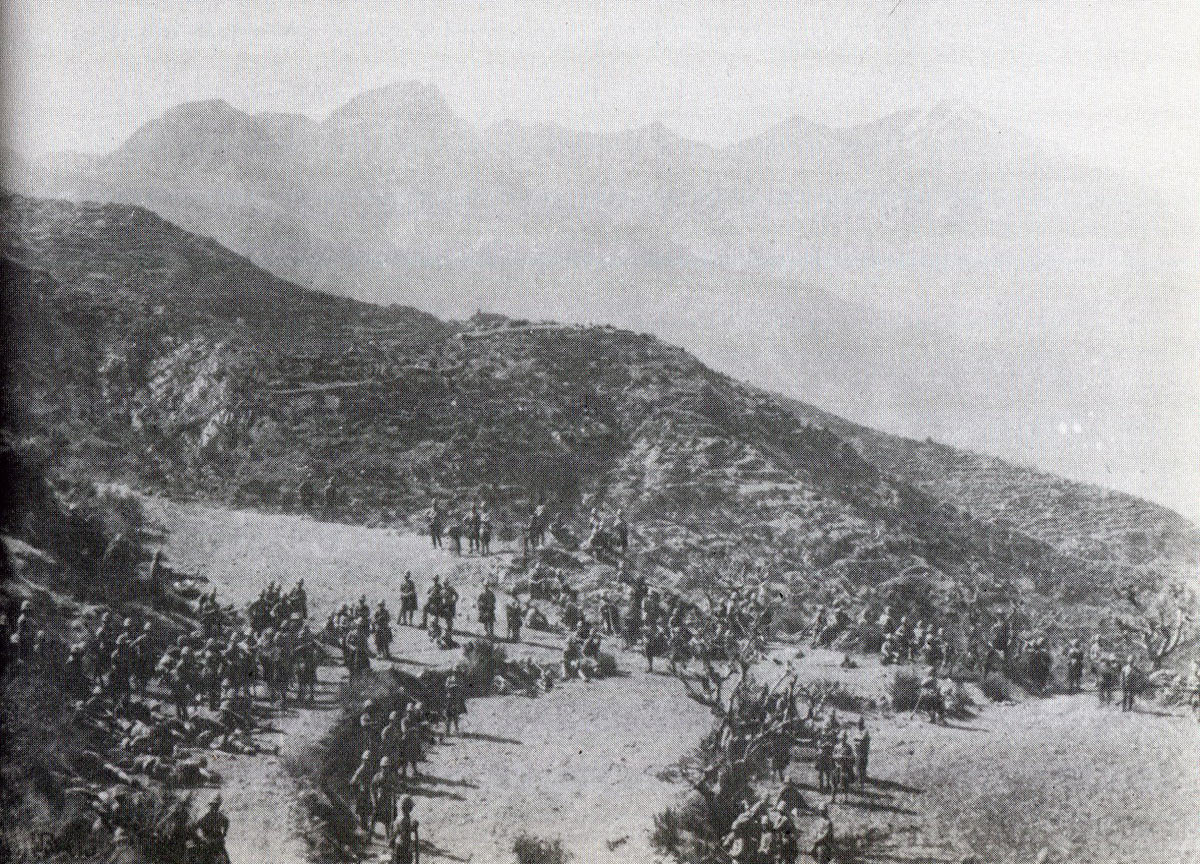
2nd Seaforth Highlanders on Diliarai Heights: Black Mountain Expedition, 1st March 1891 to 29th May 1891 on the North-West Frontier in India
Mian Gul, the rule of Swat, was reported to have arrived at Baio. But there appeared to be no display of tribal standards, the usual indication of impending hostile action. The Commissioner for Peshawar wrote to Mian Gul and the Bunerwal jirga, stating that there was no intention of entering Chagarzai country or fighting with the Bunerwals, but that if the lascar at Baio did not disperse it would be attacked.
On 4th April 1891, an elderly Bunerwal sepoy in the 5th Punjab Infantry informed his officers that the lashkar at Baio was dispersing. Some standards were seen on a hill between Hassanzai and Chagarzai country. These were shelled by the mountain artillery and withdrew on the approach of troops.
On 4th April 1891, the Akazai village of Bimbal was burnt to encourage the tribe to hurry its submission.
On 7th April 1891, the Third Brigade was withdrawn from the force and marched from Darband towards Kohat, to deal with an outbreak by the Miranzai. As Baio was now reported completely deserted, the British force began its withdrawal to the east bank of the Indus River. It was also reported that Mian Gul was advising Hashim Ali to surrender to the British, but that he had refused and left for Teri, a Makki Khel village on the Buner border.
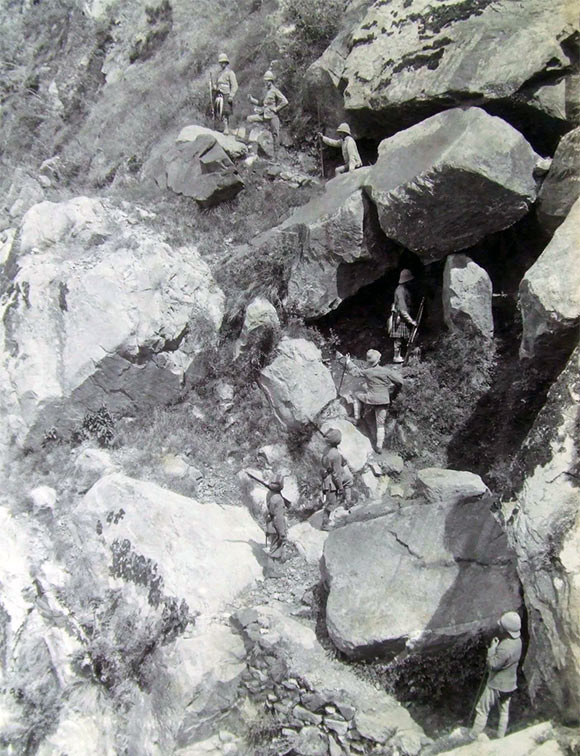
2nd Seaforth Highlanders and Indian troops moving up into the mountains: Black Mountain Expedition, 1st March 1891 to 29th May 1891 on the North-West Frontier in India
Early on 8th April 1891, the divisional headquarters, escorted by the Guides Infantry left Palosi, crossed the Indus River by the flying bridge at Bakrai and took the road through Makranai to Ril. The road was steep and difficult, particularly for the baggage animals. The rear-guard arrived at around 7.30pm. The Seaforth Highlanders with the 3 guns of No 1 Mountain Gun Battery and the HQ of First Brigade marched via the bridge of boats at Kotkai to Tilli and then to Seri. The inhabitants of Palosi were enabled to return to their village. The only British troops west of the Indus River were the 37th Dogras, guarding the Kotkai bridgehead.
The base for the Expeditionary Force was moved from Darband to Oghi, the move being completed by 24th April 1891. All posts on the Indus River in the area were abandoned, except for the one at Bakrai. The bridges were dismantled and the boats moved south. The First Brigade was now based at Seri and the Second Brigade at Darbanai. Each brigade maintained a number of outposts. A road linking the two brigade HQs was quickly built.
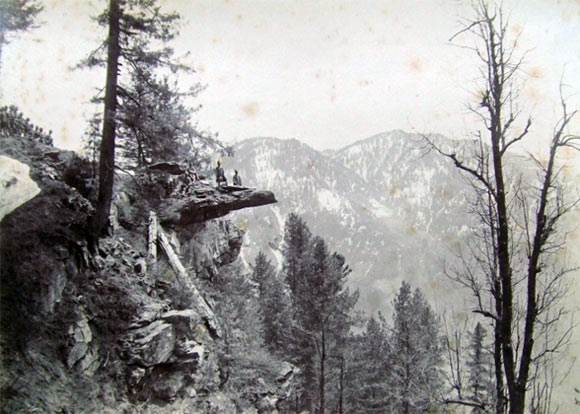
2nd Seaforth Highlanders standing on a crag: Black Mountain Expedition, 1st March 1891 to 29th May 1891 on the North-West Frontier in India
During the latter part of April and May 1891, several incursions were made into Akazai country, with villages being burnt.
On 26th May 1891, the jirgas of the Hassanzai and the Akazai came into the camp at Seri and by 29th May terms of capitulation were agreed. The most important term was that in view of the inability of the tribes to surrender Hashim Ali, as he had left the area, they undertook to exclude him from their territory. The Hassanzais, Akazais and Pariariwals undertook to escort any military force moving on the border, to ensure it was not attacked.
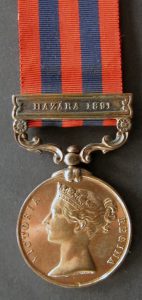
Indian General Service Medal with the clasp ‘Hazara 1891’: Black Mountain Expedition, 1st March 1891 to 29th May 1891 on the North-West Frontier in India
On 9th June 1891, the units of the force were ordered to return to their garrisons, other than a small contingent that was to remain at Seri and Oghi, commanded by Brigadier-General Hammond and comprising the Royal Welch Fusiliers, 1st/1st Gurkhas, 4th Sikh Infantry, 28th Bengal Infantry and No 9 Mountain Battery, Royal Artillery. By the end of November 1891, with further arrangements complete, including the establishment of a 200 strong Border Police Force recruited from the tribes, the remaining troops withdrew from the Black Mountain.
Casualties in the Black Mountain Expedition of 1891:
British casualties in the campaign were 9 killed and 39 wounded, including 3 officers, Second-Lieutenant Doughty of the Royal Welch Fusiliers and Lieutenants Maconchy and Harman of 4th Sikhs.
To the extent that they were known tribal casualties are set out in the text.
Battle Honour and Campaign Medal for the Black Mountain Expedition of 1891:
No battle honour was awarded for this campaign.
Soldiers who served in the campaign received the Indian General Service Medal with the clasp ‘Hazara 1891’.
For the action at Ghazikot Lieutenant Maconchy of 4th Sikhs received the Distinguished Service Order (DSO). The Indian Order of Merit Third Class was awarded to Subadar Dheru, Havildar Waziru, Naik Ganesha Singh, and Lance-Naik Alam Khan, all of 4th Sikhs or 32nd Pioneers, and Hospital Assistant Ahmadulla Khan.
Anecdotes and traditions from the Black Mountain Expedition of 1891:
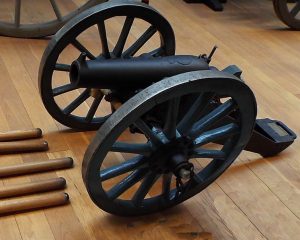
British 7 pounder RML Mountain Gun: Black Mountain Expedition, 1st March 1891 to 29th May 1891 on the North-West Frontier in India: Firepower Museum
- The 7 pounder Rifled and Muzzle Loading (‘RML’) steel mountain gun came into service with the British Army in 1873. It was superceded by the 2.3 inch gun for the Royal Artillery in 1879, but remained in service with the Indian mountain batteries. The standard charge for the gun was insufficient for use in the mountains, so a double sized shell was introduced. This shell was liable not to ignite the fuse on discharge and the long shell was liable to tumble in flight. The gun was carried on several pack mules and assembled for action. It was widely used in wars on the North-West Frontier by the Indian Army mountain batteries.
References for the Black Mountain Expedition of 1891:
The authority for campaigns on the North-West Frontier of India and other campaigns involving the Indian Army in the 19th Century is the Indian Government publication ‘Frontier and Overseas Expeditions from India’. Six volumes were published around 1905 and distributed internally, primarily to Indian Army Officers and Officials. Volume 1 covers the Black Mountain Expedition of 1891, being the volume on operations north of the Kabul River.
North West Frontier by Captain H.L. Nevill DSO, RFA
The previous battle in the North-West Frontier of India sequence is the Black Mountain Expedition 1888
The next battle in the North-West Frontier of India sequence is Waziristan 1894
To the North-West Frontier of India index
